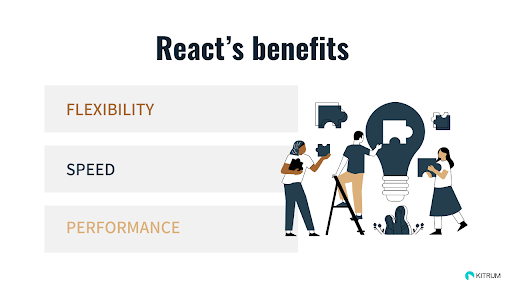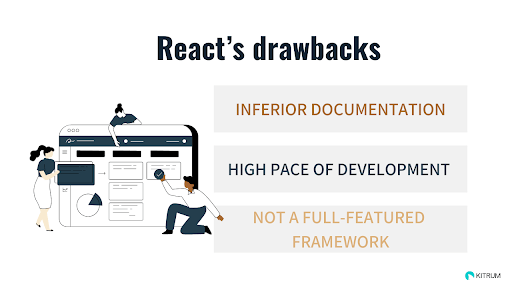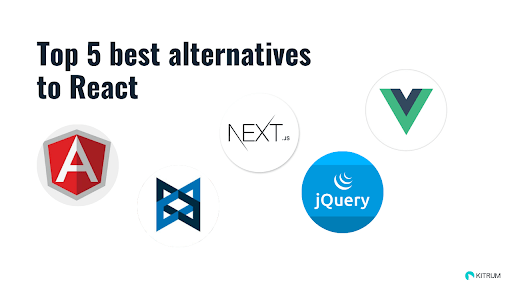Top 5 Best Alternative Frameworks to React

Top 5 Best Alternative Frameworks to React
Discover the 5 most compelling alternative React frameworks that excel in speed, efficiency, and compact file sizes, while delivering outstanding performance and unrivaled functionality for web development.
So, you've delved into the world of web development and discovered the wonders of React - a remarkable framework that has propelled countless applications to excellence. No wonder, as recent data reveals, a staggering number of websites, precisely 11,908,579, have embraced React as their preferred UI framework.
But what if we tell you there are alternative frameworks that are faster and smaller in size than React?
If you're looking for speed and efficiency without sacrificing functionality, these alternatives will leave you in awe. Bid farewell to large file sizes and welcome the lightweight champions that can optimize your code and deliver lightning-fast performance.
So, let's dive into React's advantages and drawbacks and explore the compelling alternatives available.
Looking to hire an app developer? Search for leading service providers on The Manifest.
What is React?
React is a popular open-source JavaScript framework and library for building user interfaces developed by Jordan Walke, a software engineer at Meta. It is widely used for creating dynamic and interactive web applications. React allows developers to build reusable UI components that efficiently update and render changes in response to data or user events.
React's primary role in an application is to handle the view layer of that application, just like the V in a model-view-controller (MVC) pattern, by providing the best and most efficient rendering execution.
One of the key features of React is its virtual DOM (Document Object Model) representation. Instead of directly manipulating the browser DOM, React creates a virtual copy in memory. It enables React to efficiently update only the necessary components when changes occur, resulting in faster rendering and improved performance.
React’s Benefits

React offers several advantages that make it a powerful and preferred framework for web development:
Flexibility
React follows a modular approach, where an application comprises multiple components, each responsible for rendering a specific reusable piece of code. This modular nature allows for easier development and maintenance of apps, as these components can be used as building blocks for complex applications.
Speed
React utilizes JSX, a syntax that combines HTML quotes and tag syntax, making it easier and faster to develop web apps. Developers can rapidly create web applications using HTML strings while writing JavaScript code. Besides, React enables the reuse of components on both the client and server sides, leading to accelerated development speeds.
Performance
React focuses on state management and rendering to the virtual DOM (Document Object Model), a programming API dealing with HTML, XML, or XHTML components.
Traditional DOM updates can negatively impact app performance. However, React introduces the concept of a virtual DOM, which exists entirely in memory. This optimization leads to quicker response times and enhanced overall performance of React apps.
React’s Drawbacks

Inferior Documentation
Due to the rapid pace at which React evolves, new tools and patterns are frequently introduced, making it challenging for the community to keep up and maintain comprehensive documentation.
This need for up-to-date and extensive documentation can create difficulties for new developers starting with React. It can also slow development within teams with less experienced developers, as they may need help finding adequate resources and guidance.
High Pace of Development
One of the disadvantages of using React is the high pace of development associated with it. React is a rapidly growing library and undergoes frequent changes, requiring developers to update their code-writing practices constantly.
This can be frustrating for developers who prefer stability and are uncomfortable adapting to new approaches every time they work on their projects.
In industries where stability is crucial and customers seek more established tools and technologies, the fast-paced nature of React may be challenging. However, the impact of this disadvantage can vary depending on the expertise of the team members and their ability to gain the trust of their customers in utilizing React.
Not a Full-Featured Framework
React's disadvantage is that it is not a full-featured framework like Angular. While React is powerful for building large-scale applications, it primarily focuses on the view part of the MVC architecture.
Developers need additional libraries and tools for the controller and model aspects, resulting in less structured code and patterns. Unlike Angular, React lacks complete features and structured practices in backend development.
A deeper understanding of JavaScript and its core behaviors is required to work effectively with React. Although more challenging to learn, Angular offers a strict structure aligned with backend development, providing similar patterns and practices.
Top 5 Best Alternatives to React

Angular JS
AngularJS revolutionizes web application development by extending HTML's capabilities. With AngularJS, you can create expressive and readable code that is quick to develop. It offers a flexible toolset that allows you to customize and enhance the framework to meet the specific needs of your application.
Data binding simplifies the process of updating the view and model, eliminating the need for manual DOM manipulation. Controllers provide a clean and readable way to define the behavior of DOM elements without the usual boilerplate code.
Additionally, AngularJS keeps things simple by using plain JavaScript objects for models, making your code easy to test, maintain, and reuse without unnecessary complexity.
Backbone.js
Backbone.js is a lightweight JavaScript library that simplifies the development and structure of client-side applications. It offers an MVC framework, providing models, views, events, routers, and collections as building blocks for assembling web applications.
Backbone.js effectively separates business and user interface logic with automatic HTML updates upon model changes. It serves as a reliable backbone, organizing code and managing data models.
Being free and open source, it offers over 100 available extensions and has soft dependencies on jQuery and Underscore.js. Backbone.js facilitates the creation of well-structured and organized client-side or mobile applications.
Next.js
Next.js was created by Guillermo Rauch and is preferred over React in specific scenarios due to its distinct advantages. It offers built-in server-side rendering (SSR) and static site generation (SSG), improving performance and SEO.
Next.js includes a routing system, simplifying client-side navigation. With features like automatic code splitting, hot module replacement, and TypeScript support, Next.js enhances the development experience.
It seamlessly integrates with popular frameworks and libraries and benefits from strong community support. In summary, Next.js provides a more comprehensive framework with advanced functionality, better performance, and an improved development experience compared to React alone.
jQuery
jQuery is widely recognized as one of the most prevalent JavaScript libraries available today, employed by 70% of the internet's most popular websites. This library, which is freely accessible and open-source, aims to streamline the process of navigating and modifying the HTML DOM tree. Building upon this foundation, developers can construct dynamic websites and web applications with sophisticated effects and customizable widgets.
VueJS
VueJS is rapidly emerging as a popular alternative to React, mainly geared toward crafting single-page applications and user interfaces. This JavaScript framework, which is open-source, stands out as one of the most adaptable, developer-centric, and swift alternatives currently accessible to developers.
Thanks to its flexible integration process and compact library size, Vue delivers improved performance while being more approachable and simpler to grasp than React.
What is a Better Alternative to React?
Choosing the best alternative to React requires careful consideration of your project requirements, performance, community support, and ecosystem. There is no one-size-fits-all solution, as each option has its unique strengths and weaknesses. Thorough evaluation is key to making an informed decision that aligns with your project's needs and team capabilities.
